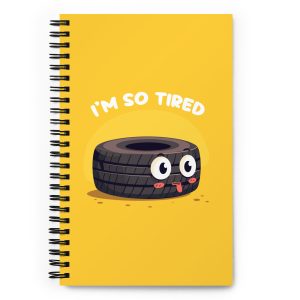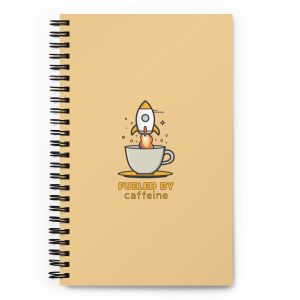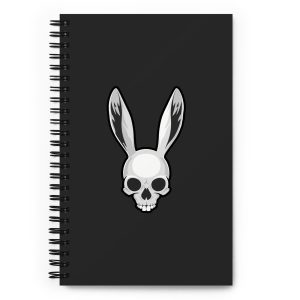Ever had a brilliant idea flash through your mind, only to forget it moments later because you didn’t have a notebook handy? We’ve all been there, frantically searching for a scrap of paper or typing a hasty note on our phones. But let’s be honest, nothing beats the satisfying click of opening a fresh, new spiral notebook and putting pen to paper.
So, what is a spiral notebook exactly? Is it just a humble school supply or something more? In this ultimate guide, we’ll dive deep into the world of spiral notebooks, exploring their history, anatomy, diverse uses, and why they remain a beloved tool for writers, students, artists, and anyone who loves to capture their thoughts and ideas on paper.
What Defines a Spiral Notebook? Anatomy and Key Features of This Note-Taking Essential
At its core, a spiral notebook is a collection of paper pages held together by a spiral binding. But don’t be fooled by its simplicity! This unassuming stationery staple is packed with features that make it incredibly versatile and user-friendly.
Let’s break down the anatomy of a spiral notebook:
-
Cover
The cover serves as the notebook’s protective shield, safeguarding your precious notes and doodles from wear and tear. It comes in a variety of materials, from sturdy cardboard to luxurious leather, and can be adorned with vibrant colors, patterns, or even personalized designs.
-
Spiral Binding
The spiral binding is the heart and soul of a spiral notebook. It allows the pages to turn freely and lie flat, making it easy to write on both sides of the paper.
Spiral bindings come in different types:
-
Wire-o binding
This classic style features a double loop wire that’s both flexible and durable.
-
Coil binding
Coil binding uses a single loop wire that’s easy to open and close, making it ideal for adding or removing pages.
-
Plastic comb binding
This type of binding is lightweight and inexpensive, but it’s not as durable as wire or coil binding.
-
Pages
The pages are where the magic happens! You’ll find spiral notebooks with lined, grid, dotted, or blank pages, catering to various writing and drawing styles. Some notebooks even offer a mix of page types, giving you the freedom to switch between different formats as needed.
Additional Features:
Many spiral notebooks come with bonus features to enhance your experience, such as:
-
Perforated pages
These allow you to easily tear out pages for sharing or archiving.
-
Pocket dividers
These provide a convenient place to store loose papers, business cards, or sticky notes.
-
Reinforced edges
These add durability and prevent the pages from tearing or fraying.
A Brief History of Spiral Notebooks: From Humble Origins to Iconic Status
The spiral notebook’s journey began in the late 19th century when inventors like Jabez Gridley and Charles Tillinghast patented early versions of spiral binding. These initial designs were primarily used for accounting ledgers and other business documents.
Over time, the spiral notebook evolved and found its way into classrooms, offices, and homes around the world. It became a beloved tool for students, writers, artists, and anyone who needed a convenient and reliable way to capture their thoughts and ideas.
Today, spiral notebooks are more popular than ever. They’ve become a cultural icon, appearing in movies, TV shows, and even fashion collections. And while technology has certainly changed the way we work and communicate, the spiral notebook remains a timeless and indispensable tool for those who appreciate the power of pen and paper.
What is a Spiral Notebook Good For? Varieties for Every Need and Whimsy
Spiral notebooks are incredibly versatile, catering to a wide range of needs and preferences. Here’s a glimpse into the diverse world of spiral notebook varieties:
-
Size
Spiral notebooks come in various sizes, from pocket-sized companions perfect for on-the-go note-taking to large-format notebooks ideal for sketching and drawing.
-
Paper Type
Whether you prefer the classic feel of lined paper, the structure of grid paper, the flexibility of dotted paper, or the blank canvas of unlined paper, there’s a spiral notebook for you. You can even find notebooks with a mix of page types, allowing you to switch between different formats as needed.
-
Cover Design and Material
Spiral notebook covers are a playground for creativity. You can find them in virtually every color and pattern imaginable, from minimalist designs to vibrant floral prints. Covers can be made from cardboard, plastic, faux leather, or even sustainable materials like recycled paper or cork.
No matter your style or intended use, there’s a spiral notebook out there that’s perfect for you.
Spiral Notebooks for Every Purpose: Unleashing Your Creativity
The beauty of spiral notebooks lies in their adaptability. They can be used for a multitude of purposes, both practical and creative. Here are a few ways you can unleash your creativity with a spiral notebook:
-
Note-taking and Studying
Spiral notebooks are the quintessential tool for taking notes in lectures, meetings, or brainstorming sessions. Their flat-lying design makes them easy to write in, and the spiral binding allows you to flip back and forth between pages effortlessly.
-
Journaling and Creative Writing
A spiral notebook can be your confidante, capturing your deepest thoughts, emotions, and creative expressions. Whether you’re writing a personal diary, a travel journal, or a collection of poems, the spiral notebook provides a blank canvas for your words to flow freely.
-
Planning and Organization
Use your spiral notebook to create to-do lists, calendars, project plans, and goal trackers. The ability to add or remove pages makes it easy to adapt your notebook to your evolving needs.
-
Sketching and Drawing
Artists and doodlers love spiral notebooks for their portability and convenience. The spiral binding allows the notebook to lie flat, providing a stable surface for sketching and drawing.
Maximizing Your Spiral Notebook Experience: Tips and Tricks
Ready to take your spiral notebook game to the next level? Here are some tips and tricks to make the most of this versatile stationery staple:
-
Color-Coding
Use different colored pens or highlighters to categorize your notes, making them easier to review and study.
-
Sticky Notes
Attach sticky notes to pages for quick reminders, annotations, or even miniature works of art.
-
Washi Tape
Decorate your spiral notebook with colorful washi tape to add a touch of personality and flair.
-
Index Cards
Create an index card system to quickly reference key information or organize your notes by topic.
-
Digital Integration
If you prefer a hybrid approach, consider using a smartpen that can digitize your handwritten notes and sync them to your devices.
Spiral Notebooks in the Digital Age: A Timeless Tool
In an era of digital note-taking apps and cloud storage, you might wonder why spiral notebooks remain so popular. The answer lies in their unique blend of simplicity, versatility, and the tactile satisfaction of putting pen to paper.
Studies have shown that handwriting can enhance learning and memory, as it activates different parts of the brain compared to typing. The physical act of writing helps to solidify information and make it more memorable. Additionally, spiral notebooks offer a break from screen time and a chance to disconnect from the digital world.
Conclusion: The Spiral Notebook – A Versatile Companion for Life
The spiral notebook is more than just a school supply or office essential; it’s a versatile companion for life. Whether you’re jotting down a grocery list, sketching a masterpiece, or pouring your heart out in a journal entry, the spiral notebook is there to capture your thoughts, ideas, and creativity.
So, the next time you reach for a spiral notebook, take a moment to appreciate its rich history, its adaptability, and its enduring appeal. In a world that’s constantly evolving, the spiral notebook remains a timeless tool that empowers us to express ourselves, learn, and create.
Curious about how spiral notebooks get their signature binding? Discover the fascinating process and history of coil binding on Wikipedia!
https://en.wikipedia.org/wiki/Coil_binding
































